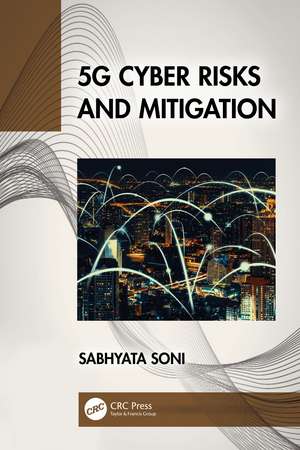5G Cyber Risks and Mitigation
Autor Sabhyata Sonien Limba Engleză Paperback – 7 oct 2024
5G networks will use new technologies that could make them more vulnerable to attacks. These technologies include massive multiple input, multiple output (MIMO), which uses more antennas than traditional cellular networks, and millimeter wave (mmWave), which uses higher frequencies than traditional cellular networks. These new technologies could make it easier for attackers to intercept data or disrupt service.
To address these concerns, security measures must be implemented throughout the network. Security mechanisms must be included in the design of 5G networks and must be updated as new threats are identified.
Moreover, to address these risks, 5G security standards need to be developed and implemented. These standards should include measures to protect against Denial of Service (DoS) attacks, malware infections, and other threats.
Fortunately, Artificial Intelligence (AI) can play a key role in mitigating these risks. With so many interconnected devices, it can be difficult to identify and isolate malicious traffic. AI can help by identifying patterns in data that would otherwise be undetectable to humans.
6G technology is still in the early developmental stages, but security experts are already voicing concerns about the potential challenges that could arise with this next generation of mobile connectivity. Experts are already working on a roadmap for 6G deployment, and they are confident that these and other challenges can be overcome.
| Toate formatele și edițiile | Preț | Express |
|---|---|---|
| Paperback (1) | 259.01 lei 6-8 săpt. | |
| CRC Press – 7 oct 2024 | 259.01 lei 6-8 săpt. | |
| Hardback (1) | 719.90 lei 3-5 săpt. | +22.97 lei 4-10 zile |
| CRC Press – 13 apr 2023 | 719.90 lei 3-5 săpt. | +22.97 lei 4-10 zile |
Preț: 259.01 lei
Preț vechi: 373.15 lei
-31% Nou
Puncte Express: 389
Preț estimativ în valută:
49.57€ • 51.21$ • 41.25£
49.57€ • 51.21$ • 41.25£
Carte tipărită la comandă
Livrare economică 25 martie-08 aprilie
Preluare comenzi: 021 569.72.76
Specificații
ISBN-13: 9781032206134
ISBN-10: 1032206136
Pagini: 222
Ilustrații: 56
Dimensiuni: 156 x 234 mm
Greutate: 0.41 kg
Ediția:1
Editura: CRC Press
Colecția CRC Press
Locul publicării:Boca Raton, United States
ISBN-10: 1032206136
Pagini: 222
Ilustrații: 56
Dimensiuni: 156 x 234 mm
Greutate: 0.41 kg
Ediția:1
Editura: CRC Press
Colecția CRC Press
Locul publicării:Boca Raton, United States
Public țintă
Academic, Postgraduate, and ProfessionalCuprins
1. Overview of 5G network, architecture, and Uses. 2. 5G use cases and application. 3. Security in the 5G Era. 4. Security standards and their role in 5G. 5. Differentiating 4G and 5G on a security Basis. 6. 5G, IoT, and cyber risk. 7. 5G security risk. 8. Security for 5G mobile wireless networks. 9. Security Risk Prevention and Control Deployment for 5G Private Industrial Networks. 10. 5G Threat Surface And Threat Mitigation Control. 11. Role of AI in mitigation of 5G attacks. 12. Road to future 6G and security challenges.
Notă biografică
Dr. Sabhyata Soni is a Ph.D. (Electronics & Communications Engineering) from Thapar University Patiala. She has more than twenty years of experience teaching in the topmost engineering colleges of India. Her research papers are published in many reputed and highly ranked international journals. Currently, she is teaching as a senior faculty at the University Institute of Engineering and Technology(UIET), affiliated with one of India's oldest universities, the Panjab University (PU), Chandigarh.
Descriere
5G technology is the next step in the evolution of wireless communication. However, it also introduces new cyber risks. 5G networks are expected to be much more complex, making them harder to secure. Fortunately, artificial intelligence can play a key role in mitigating these risks.
